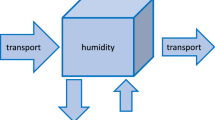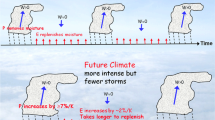Abstract
Future changes in precipitation represent one of the most important and uncertain possible effects of future climate change. We demonstrate a new approach based on idealised CO2 step-change general circulation model (GCM) experiments, and test it using the HadCM3 GCM. The approach has two purposes: to help understand GCM projections, and to build and test a fast simple model for precipitation projections under a wide range of forcing scenarios. Overall, we find that the CO2 step experiments contain much information that is relevant to transient projections, but that is more easily extracted due to the idealised experimental design. We find that the temporary acceleration of global-mean precipitation in this GCM following CO2 ramp-down cannot be fully explained simply using linear responses to CO2 and temperature. A more complete explanation can be achieved with an additional term representing interaction between CO2 and temperature effects. Energy budget analysis of this term is dominated by clear-sky outgoing long-wave radiation (CSOLR) and sensible heating, but cloud and short-wave terms also contribute. The dominant CSOLR interaction is attributable to increased CO2 raising the mean emission level to colder altitudes, which reduces the rate of increase of OLR with warming. This behaviour can be reproduced by our simple model. On regional scales, we compare our approach with linear ‘pattern-scaling’ (scaling regional responses by global-mean temperature change). In regions where our model predicts linear change, pattern-scaling works equally well. In some regions, however, substantial deviations from linear scaling with global-mean temperature are found, and our simple model provides more accurate projections. The idealised experiments reveal a complex pattern of non-linear behaviour. There are likely to be a range of controlling physical mechanisms, different from those dominating the global-mean response, requiring focussed investigation for individual regions, and in other GCMs.










Similar content being viewed by others
References
Allen MR, Ingram WJ (2002) Constraints on future changes in climate and the hydrologic cycle. Nature 419(6903):224–232
Andrews T, Forster PM, Gregory JM (2009) A surface energy perspective on climate change. J Clim 22(10):2557–2570
Arribas A et al (2010) The GloSea4 ensemble prediction system for seasonal forecasting. Mon Wea Rev 139(6):1891–1910
Betts RA, Cox PM, Lee SE, Woodward FI (1997) Contrasting physiological and structural vegetation feedbacks in climate change simulations. Nature 387(6635):796–799
Cao L, Bala G, Caldeira K (2011) Why is there a short-term increase in global precipitation in response to diminished CO2 forcing? Geophys Res Lett 38:L06703. doi:10.1029/2011GL046713
Cess RD, Potter GL (1988) A methodology for understanding and intercomparing atmospheric climate feedback processes in general-circulation models. J Geophys Res Atmos 93(D7):8305–8314
Chou C, Neelin JD, Chen CA, Tu JY (2009) Evaluating the “Rich-Get-Richer’’ mechanism in tropical precipitation change under global warming. J Clim 22(8):1982–2005
Draper NR, Smith H (1981) Applied regression analysis. Wiley, London
Emori S, Brown SJ (2005) Dynamic and thermodynamic changes in mean and extreme precipitation under changed climate. Geophys Res Lett 32:L17706. doi:10.1029/2005GL023272
Frieler K, Meinshausen M, von Deimling TS, Andrews T, Forster P (2011) Changes in global-mean precipitation in response to warming, greenhouse gas forcing and black carbon. Geophys Res Lett 38:L04702. doi:10.1029/2010GL045953
Good P, Lowe J (2006) Emergent behaviour and uncertainty in multimodel climate projections of precipitation trends at small spatial scales. J Clim 19(21):5554–5569
Good P, Barring L, Giannakopoulos C, Holt T, Palutikof J (2006) Non-linear regional relationships between climate extremes and annual mean temperatures in model projections for 1961–2099 over Europe. Clim Res 31(1):19–34
Good P, Lowe JA, Rowell DP (2009) Understanding uncertainty in future projections for the tropical Atlantic: relationships with the unforced climate. Clim Dyn 32(2–3):205–218
Good P, Gregory JM, Lowe JA (2011) A step-response simple climate model to reconstruct and interpret AOGCM projections. Geophys Res Lett 38:L01703. doi:10.1029/2010GL045208
Gordon C, Cooper C, Senior CA, Banks H, Gregory JM, Johns TC, Mitchell JFB, Wood RA (2000) The simulation of SST, sea ice extents and ocean heat transports in a version of the Hadley Centre coupled model without flux adjustments. Clim Dyn 16(2–3):147–168
Gregory J, Webb M (2008) Tropospheric adjustment induces a cloud component in CO2 forcing. J Clim 21(1):58–71
Gregory JM, Ingram WJ, Palmer MA, Jones GS, Stott PA, Thorpe RB, Lowe JA, Johns TC, Williams KD (2004) A new method for diagnosing radiative forcing and climate sensitivity. Geophys Res Lett 31:L03205. doi:10.1029/2003GL018747
Hasselmann K, Sausen R, Maierreimer E, Voss R (1993) On the cold start problem in transient simulations with coupled atmosphere-ocean models. Clim Dyn 9(2):53–61
Held IM, Soden BJ (2006) Robust responses of the hydrological cycle to global warming. J Clim 19(21):5686–5699
Huntingford C, Cox PM (2000) An analogue model to derive additional climate change scenarios from existing GCM simulations. Clim Dyn 16(8):575–586
Huntingford C, Lowe JA, Booth BBB, Jones CD, Harris GR, Gohar LK, Meir P (2009) Contributions of carbon cycle uncertainty to future climate projection spread. Tellus Ser B Chem Phys Meteorol 61(2):355–360
Ingram W (2010) A very simple model for the water vapour feedback on climate change. Q J Roy Meteorol Soc 136(646):30–40
Lambert FH, Faull NE (2007) Tropospheric adjustment: the response of two general circulation models to a change in insolation. Geophys Res Lett 34(3):L03701. doi:10.1029/2006GL028124
Lambert FH, Webb MJ (2008) Dependency of global mean precipitation on surface temperature. Geophys Res Lett 35:L16706. doi:10.1029/2008GL034838
Meinshausen M, Raper SCB, Wigley TML (2008) Emulating coupled atmosphere-ocean and carbon cycle models with a simpler model, MAGICC6—Part 1: model description and calibration. Atmos Chem Phys 11:1417–1456. doi:10.5194/acp-11-1417-2011
Mitchell TD (2003) Pattern scaling—an examination of the accuracy of the technique for describing future climates. Clim Chang 60(3):217–242
Mitchell JFB, Wilson CA, Cunnington WM (1987) On CO2 climate sensitivity and model dependence of results. Q J Roy Meteorol Soc 113(475):293–322
Nakicenovic N et al (2000) IPCC special report on emissions scenarios. Cambridge University Press, Cambridge
Pope VD, Gallani ML, Rowntree PR, Stratton RA (2000) The impact of new physical parametrizations in the Hadley Centre climate model: HadAM3. Clim Dyn 16(2–3):123–146
Raisanen J, Ylhaisi JS (2011) How much should climate model output be smoothed in space? J Clim 24(3):867–880
Raisanen J, Hansson U, Ullerstig A, Doscher R, Graham LP, Jones C, Meier HEM, Samuelsson P, Willen U (2004) European climate in the late twenty-first century: regional simulations with two driving global models and two forcing scenarios. Clim Dyn 22(1):13–31
Santer B, Wigley T, Schlesinger M, Mitchell JFB (1990) Developing climate scenarios from equilibrium GCM results, Report No. 47, Max Planck Institute for Meteorology, Hamburg
Seager R, Naik N, Vecchi GA (2010) Thermodynamic and dynamic mechanisms for large-scale changes in the hydrological cycle in response to global warming. J Clim 23(17):4651–4668
Simpson GC (1928) Some studies in terrestrial radiation. Mem R Meteorol Soc 2:69–95
Solomon S, Qin D, Manning M, Chen Z, Marquis M, Averyt KB, Tignor M, Miller HL (2007) Contribution of working Group I to the fourth assessment report of the intergovernmental panel on climate change. Cambridge University Press, Cambridge
Wetherald RT, Manabe S (2002) Simulation of hydrologic changes associated with global warming. J Geophys Res Atmos 107:4379. doi:10.1029/2001JD001195
Wu PL, Wood R, Ridley J, Lowe J (2010) Temporary acceleration of the hydrological cycle in response to a CO2 rampdown. Geophys Res Lett 37:L12705. doi:10.1029/2010GL043730
Xie SP, Deser C, Vecchi GA, Ma J, Teng HY, Wittenberg AT (2010) Global warming pattern formation: sea surface temperature and rainfall. J Clim 23(4):966–986
Yang FL, Kumar A, Schlesinger ME, Wang WQ (2003) Intensity of hydrological cycles in warmer climates. J Clim 16(14):2419–2423
Acknowledgments
This work was supported by the Joint UK DECC/Defra Met Office Hadley Centre Climate Programme (GA01101). Comments from two anonymous reviewers led to significant improvements in the manuscript.
Author information
Authors and Affiliations
Corresponding author
Appendices
Appendix 1
The coefficients (A, B and C) in Eq. 2 are derived simultaneously by least-squares regression using the multi-linear regression (Draper and Smith 1981) library routine in IDL. Three variables are supplied to the regression routine: ln(CO2), T and ln(CO2)T (David Stephenson, personal communication), along with the dependent variable (P). Data from the three step experiments (4x_step, 2x_step and 4x_1x_step) and the control run are combined together for the regression.
Results from the projections were withheld from the regression and used only for validation.
Appendix 2
Under the grey assumption (that optical depths do not vary with wavelength), the OLR flux F can be expressed as a function of an “effective emitting temperature” Teff:
Differentiating and rearranging:
Taking the OLR forcing from CO2-doubling (ΔF) as around 4 W/m2, OLR (F) as 220 W/m2 and Teff as 220 K makes ΔTeff, the cooling of the effective level of emission due to CO2-doubling, around 1 K.
To get the change of dF/dT due to increased CO2 (assuming that the effect of increased CO2 is to raise the effective emission level to higher altitude and hence reduce Teff), we differentiate again twice to give:
Using the values of F and Teff quoted above, the change of dF/dT due to CO2 doubling is around 0.05 W/m2/K.
According to our SCM fit, the 5–95 % CI of the change in dF/dT due to CO2 doubling (Fig. 5c) is (0.125–0.175)·ln(2) = (0.08–0.12) W/m2/K.
Rights and permissions
About this article
Cite this article
Good, P., Ingram, W., Lambert, F.H. et al. A step-response approach for predicting and understanding non-linear precipitation changes. Clim Dyn 39, 2789–2803 (2012). https://doi.org/10.1007/s00382-012-1571-1
Received:
Accepted:
Published:
Issue Date:
DOI: https://doi.org/10.1007/s00382-012-1571-1




